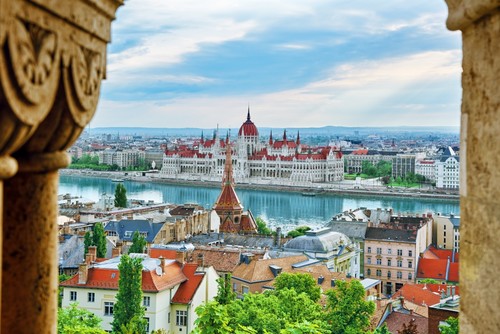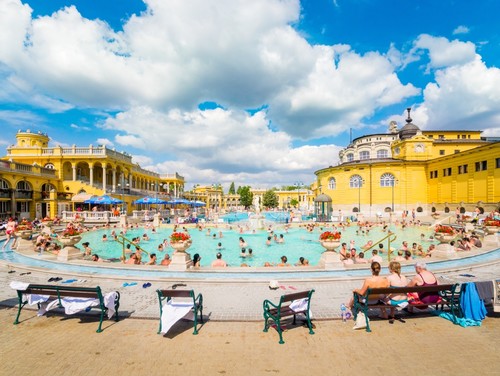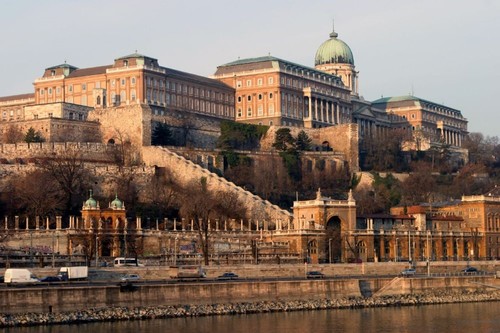© Turkuvaz Haberleşme ve Yayıncılık 2024
Water brings serenity to almost any place and walking down the River Danube, it is easy to fall in love with Budapest. It is probably the best place to get lost, the best place to go crazy and an even better place to chill and educational vacation.
Split into two as Buda and Pest by the River Danube, Budapest and its art nouveau facades, old-fashioned cafes and hot springs welcome you to a historic city with a modern twist.
Traveling to Budapest from Istanbul is quite easy. You can hop on a plane from both airports in the city. It is also easy to find affordable tickets if you have time to plan your trip ahead. I managed to find round-trip tickets for about TL 500 ($126) and considering that I bought the tickets just one month before the trip, I call it a good bargain. From Istanbul to Budapest, it is only a two-hour flight and thanks to the time difference, you can make up the two hours you spend on the plane when you land because you have to put the clock back two hours in Hungary.
Budapest is a very affordable destination for budget travelers as well. You can have your lunch for just a couple of euros. Yes, Budapest is quite a cheap city but if you want to save more money, you can choose to stay in the Buda side which is cheaper and much closer to the lively Pest side you think. As long as you find a hotel by the River Danube, you can go the the other side of the city by just walking through a bridge. However, it is good to keep in mind that Hungary still uses its own currency, the forint, and it is better to change your money into Hungarian forint as soon as you land.
It is said that the best time to visit Budapest is between April and September as the weather is warmer and the city is more alive. As a person who prefers to avoid crowds especially during summer - heat, sweat, nah - I planned my visit to the city in March and it was just perfect. Being one of the most touristic capitals in Eastern Europe, Budapest is a delight to see during the off-season. The museums are relatively empty, the streets are all yours to get lost in and discover and after some time I believe you can almost pretend to be a local as the city is so welcoming.
After landing at Budapest Ferenc Liszt International Airport, it is a long trip to the town center but thanks to the public transportation network of the city, you can get wherever you want even if you have to change two buses and three metro lines. You can purchase a 24-hour public transportation ticket and hop on and off buses, metros or trams anytime you want. However, there is a catch: the 100E, the bus that takes you from airport to the city center, does not accept this 24 hour ticket so you have to pay for an extra ticket if you want a quick access to the city center.
Traveling to the city, it is astonishing to realize that Budapest is a much smaller city than you imagine. As a resident of Istanbul, which is also composed of two different sides cut by the mighty Bosporus, somehow, Budapest seems small and almost impossible to get lost in, which I proved at the end of my trip.
The city might seem small but do not get me wrong, it has lot to offer. First of all, the bridges connecting Buda to Pest are incredible. The Chain Bridge is perhaps the most beautiful one to walk on. You can walk across it from Buda to Pest and back - an excellent way to absorb the World Heritage sights and panorama and to take wonderful photos with lion statues accompanying you as you cross it .For centuries, the Chain Bridge was only a pontoon bridge connecting Buda and Pest. Count Istvan Szechenyi, one of the most important historic figures of the country, decided to build a stronger bridge to connect both sides of the River Danube for an easy passage to the parliament building on the Pest side. Even though it took him almost 50 years, the bridge finally came into being and became one of the most used bridges in the city as well as a delight for tourists. The current bridge, however, came into being in 1949 as the original one was destroyed by Nazi Germany during World War II.

PESTOn the first day of my two-day weekend trip, my travel companion and I decided to discover the Pest side as it was more appealing. Once you cross the Danube through the bridge, a busy square welcomes you. After we discover that the map we bought was useless, we decided to walk through the city guided by our guts and we were not wrong. It is incredible to get lost and find your way again in Budapest and by the end of the day you will probably learn every avenue and street of the city by heart.
Pest is a touristic spot. You can easily find the world's most beloved cuisines and have a quick lunch. Much to my surprise though, there is really nothing called the Hungarian cuisine. On every street I wandered, there were Japanese, Italian and even Turkish restaurants but I failed to see any sign of an authentic Hungarian restaurant that would lure me in.
Once your belly is full, head to the biggest Roman Catholic church of the city which is St. Stephen's Basilica named in the honor of Stephen, the first king of Hungary. Located in the heart of the city, the basilica also displays the mummified right hand of King Stephen as a sacred relic. As the informative signs in the church puts it, the location of the basilica was decided long before the city was rebuilt. The site of today's basilica was a theater in the 18th century. The building is a neoclassical masterpiece with a Greek cross floor plan. Fun fact: At first, the building was supposed to be named after Saint Leopold, the patron saint of Austria, but the plan was changed at the very last minute before the opening of the basilica in 1905, so it became St. Stephen's Basilica.
Since you are in the Pest side, you should definitely walk by the Andrassy Avenue, which is - in a way - the Champ Elysee of Budapest. The avenue is adorned with 19th century buildings and high- end fashion stores whose windows are always a delight to sore eyes. As you walk, one thing that you cannot miss is the Opera House.
The Hungarian State Opera House is considered a masterpiece of Miklos Ybl, one of the greatest Hungarian architects of all time. A mixture of neorenaissance style and baroque, the opera house was opened in 1884. After arriving at the building, we learned that it was under renovation until the spring of 2019 but the tour of the building was still available and to make up for the renovation, the opera house offers 10 minutes of a live opera performance with a music from a tape. Walking down in the halls of the opera house, it is impossible not to be amazed by the determination of the Hungarians. While the building was being constructed, the city of Budapest paid for all its costs. Given the fact that the city did not have such a large sum, they asked money from the Austrian empire and he gave the money on one condition: They cannot build a bigger opera house than the one in Vienna. Despite all that, the city of Budapest hired the most talented architect to lay down the project and the most talented Hungarian painter of his time to decorate the walls.
After walking down the streets of Budapest, we were planning to see the parliament building but discovering the city took all of our first day. After a great dinner and a couple of drinks, we took the Chain Bridge to walk down to our hotel.
On our second and last day, we took the metro with one mission on our minds: The famous thermal spas of Budapest. During the Ottoman rule in the 16th century, the Ottomans constructed many prominent bathing facilities within the city and some of the baths that the Turks erected during their rule are still in use 500 years later such as the Rudas and Kiraly Baths. However, our target was the biggest thermal bath of all of Europe, which is the Szechenyi Thermal Bath.

Accessible with a short metro trip, Szechenyi is located in the City Park, was built in a neobaroque style. On the outside, it looks like any other late 19th century buildings that you can find anywhere in town but on the inside, it is another story. As you walk in the building a smell of sulphate welcomes you. After buying your ticket and bracelets that are also a key for the cabins and lockers, you find yourself in an oasis in your bikinis on a cold, March day. Although there are small pools inside the building, the main entertainment is on the outside of the building. There are three sections of the thermal pools: A large Olympic sized pool in which you can swim features two small pools on both sides. Despite the cold, once you go in the pools, your body relaxes with the warm water and you never want to go out ever again. To our luck, one of the small pools was under renovation and the large pool was too cold to swim in so we found ourselves inside warm water with some 70 or more people. I did not mind though. Having a chance to be in water outside in the cold was a blessing for me. We stayed until our fingers and toes wrinkled.
BUDA
After leaving Szechenyi, we did not want to wander around aimlessly so we headed back home - after one-and-a-half day Buda became home - and went to see the mighty Buda Castle nested on the highest hill of the city.

Buda Castle is the historical castle and palace complex of the Hungarian kings in Budapest. It was first completed in 1265 yet the building you will find today dates back to the 18th century, the reason of which I will come to later. You climb the hill with the Castle Hill Funicular and find yourself in an enormous complex of buildings. The palace consists of a number of wings arranged around the Lion Courtyard. The courtyard is bordered by the National Library and two museums, the National Gallery and the Budapest History Museum. As the castle looks over the entire city from above, it is needless to say that the Castle Hill and the Buda Castle has an amazing panoramic view of the city.
BUDAPEST
In the beginning, I said that Budapest is a small city, right? Well, it is definitely not. During our two-day getaway to Eastern Europe, I believe we could not even cover half of the city. In fact, Budapest is so enjoyable to get lost and discover that I did not even want to pay a visit to all its monuments, and prefer to get to know the soul of the city and its people. I was not able to see the Great Market Place, the Great Synagogue, Parliament, Margaret Island and Ecseri Flea Market but I promised myself to save them for my second trip to the city.
It was strange to see the Ottoman traces as I stroll down the streets as well as the National Gallery and see history from the eyes of the others instead of what I heard in history classes. Overall, if you are a history junkie, a two-day trip to Budapest will not cut it for you. But if two days is all you can do, just enjoy every moment of it.
HISTORY FLASHBACK
According to historians, Budapest was first settled by the Celts and then became an important city in the region during the Roman Empire. In the ninth century, the Magyar tribes forced the Bulgarian settlers of the cities of Buda and Pest and in the 10th century founded the Hungarian Empire. Buda later became the capital of the empire and managed to repel the Tatar invasions, however, the city was captured by the Ottoman Empire after the Battle of Mohacs in 1526 and the medieval Kingdom of Hungary collapsed. The Ottoman rule in modern-day Budapest lasted for 140 years and the empire had a great impact on the city both socially and historically. During the occupation of the city of Buda by the Ottomans, the medieval Buda Castle was not harmed.
The fall of the Buda Castle, which was once the glory of the Hungarian kings, was during the great siege of 1686 when Buda was captured by allied Christian forces.
The 19th century was the start of the Hungarian strug
gle for independence and modernization. The unrest against the Habsburgs of the Austrian Empire began in the Hungarian capital in 1848 and was defeated one-and-a-half years later, with the help of the Russian Empire. The year 1867 was the year of reconciliation that brought about the birth of Austria-Hungary. This made Budapest the twin capital of a dual monarchy.
However, Budapest's glory days were short. In 1918, at the end of World War II, Austria-Hungary lost the war and collapsed; Hungary declared itself an independent republic although it lost two-third of its lands. Less than three decades later, the city was close to destruction due to the airstrikes of British and U.S. air forces during World War II. From the 1960s to the late 1980s, the city rebuilt itself and after the Fall of the Iron Curtain in the late 80s and early 90s, the city found its identity, socially and politically.
